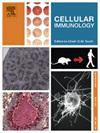Tim-3 对 MHC-II 的泛素化和降解抑制了抗病毒免疫。
IF 2.9
4区 医学
Q2 CELL BIOLOGY
引用次数: 0
摘要
我们以前曾报道过免疫检查点抑制剂 Tim-3 可抑制 MHC-II 的表达,但其中的分子机制及其对抗病毒免疫的影响仍有待确定。在这里,我们发现在 H1N1 感染期间,Tim-3 在体外抑制巨噬细胞/小胶质细胞中 MHC-II 的表达。Tim-3 通过其细胞内尾部与 MHC-II 相互作用,并诱导蛋白酶体依赖性降解 MHC-II。在 H1N1 感染的巨噬细胞/小胶质细胞中,Tim-3 通过 MARCH8(一种可被 Tim-3 上调的泛素 E3 连接酶)促进与 K48 连接的 MHC-II 泛素化。在感染 H1N1 病毒的小鼠中,巨噬细胞中 Tim-3 的特异性敲除会导致病毒载量降低,减轻组织损伤并提高存活率。因此,我们发现了 Tim-3 介导病毒免疫逃逸的新机制。操纵 Tim-3-MHC-II 信号通路可能为病毒感染提供一种新的治疗方法。本文章由计算机程序翻译,如有差异,请以英文原文为准。
Ubiquitination and degradation of MHC-II by Tim-3 inhibits antiviral immunity
We previously reported that Tim-3, an immune checkpoint inhibitor, inhibits MHC-II expression, but the molecular mechanisms involved and the implications for antiviral immunity remain to be determined. Here, we found that during H1N1 infection, Tim-3 inhibits MHC-II expression in macrophages/microglia in vitro. Tim-3 interacts with MHC-II via its intracellular tail and induces proteasomal dependent degradation of MHC-II. In H1N1 infected macrophages/microglia, Tim-3 promotes the K48-linked ubiquitination of MHC-II via MARCH8, a ubiquitin E3 ligase that can be upregulated by Tim-3. In H1N1 infected mice, specific knockout of Tim-3 in macrophages leads to a decreased viral load, attenuates tissue damage and increases the survival rate. We have thus identified a novel mechanism by which Tim-3 mediates virus immune escape. Manipulating the Tim-3-MHC-II signaling pathway may provide a novel treatment for viral infections.
求助全文
通过发布文献求助,成功后即可免费获取论文全文。
去求助
来源期刊

Cellular immunology
生物-免疫学
CiteScore
8.20
自引率
2.30%
发文量
102
审稿时长
30 days
期刊介绍:
Cellular Immunology publishes original investigations concerned with the immunological activities of cells in experimental or clinical situations. The scope of the journal encompasses the broad area of in vitro and in vivo studies of cellular immune responses. Purely clinical descriptive studies are not considered.
Research Areas include:
• Antigen receptor sites
• Autoimmunity
• Delayed-type hypersensitivity or cellular immunity
• Immunologic deficiency states and their reconstitution
• Immunologic surveillance and tumor immunity
• Immunomodulation
• Immunotherapy
• Lymphokines and cytokines
• Nonantibody immunity
• Parasite immunology
• Resistance to intracellular microbial and viral infection
• Thymus and lymphocyte immunobiology
• Transplantation immunology
• Tumor immunity.
 求助内容:
求助内容: 应助结果提醒方式:
应助结果提醒方式:


